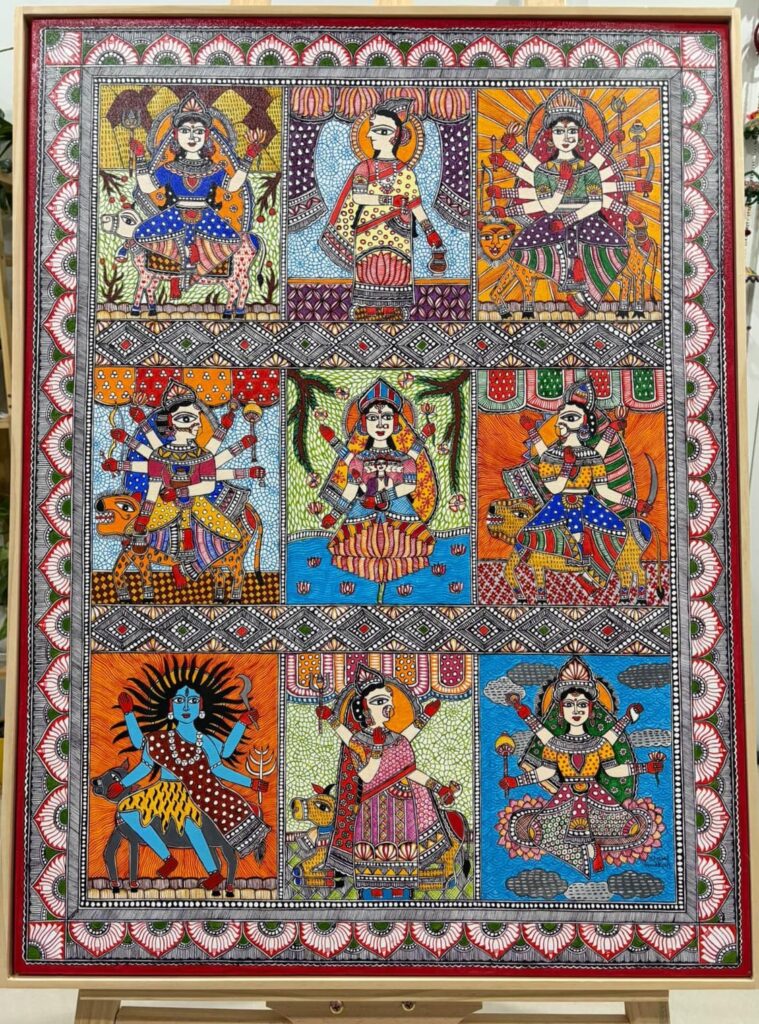
Title: Navdurga – The Nine Divine Forms
This vibrant Madhubani painting celebrates the nine manifestations of Goddess Durga, collectively known as Navdurga, each reverently depicted within ornate panels framed by traditional motifs. Executed in the rich folk tradition of Bihar’s Mithila art, the painting bursts with color, geometry, and divine symbolism.
Each square represents a distinct avatar—Shailaputri, Brahmacharini, Chandraghanta, Kushmanda, Skandamata, Katyayani, Kalaratri, Mahagauri, and Siddhidatri—each form worshipped during the nine nights of Navratri. Rendered with intricate line work, fine detailing, and natural pigments, the deities are shown with their characteristic mounts, mudras, and attributes, narrating tales of strength, grace, and cosmic balance.
Top Row
1. Shailaputri (Daughter of the Mountains)
Shailaputri, the first form of Durga, is depicted riding a bull (Nandi) and holding a trident (trishul) and lotus. She represents the elemental forces of nature and is revered as the purest embodiment of divine feminine energy. In the painting, she is adorned with intricate ornaments and calm poise, symbolizing her rootedness in strength and serenity.
2. Brahmacharini (The Ascetic)
This serene form of the goddess holds a rosary (japa mala) and a kamandalu (water pot). She walks barefoot and wears a simple white saree, signifying penance, devotion, and meditation. The background detailing reflects tranquility and spiritual awakening, staying true to her identity as the goddess of austerity.
3. Chandraghanta (Warrior Goddess)
Seated on a tiger, Chandraghanta is portrayed with a crescent moon on her forehead, from which she derives her name. She carries multiple weapons in her ten arms, ready to fight evil. The bright orange and golden tones behind her evoke the energy of battle and her role as a fierce protector.
Middle Row
4. Kushmanda (Creator of the Universe)
Known as the cosmic creator, Kushmanda is shown riding a lion and holding various weapons and a pot of nectar (amrit). Her gentle smile reflects her power to sustain and nourish the universe. The glowing backdrop hints at the primordial light she brings into existence with her divine laughter.
5. Skandamata (Mother of Skanda)
This maternal form sits peacefully with the child Skanda (Kartikeya) on her lap, riding a lion. She holds lotuses and symbolizes selfless love and strength through motherhood. The central placement in your artwork honors her as the heart of divine compassion and maternal guidance.
6. Katyayani (The Fierce Warrior)
A manifestation born from the collective anger of the gods, Katyayani is shown with multiple arms carrying weapons, mounted on a majestic lion. Her bold stance and vivid colors depict her warrior spirit, ready to vanquish demons and restore cosmic order.
Bottom Row
7. Kalaratri (The Dark Goddess)
This fearsome form is shown with untamed black hair, blue body, and bloodshot eyes, riding a donkey. She holds a scimitar and a thorn whip, and her outstretched hand offers protection. Surrounded by flames and darkness, she represents the destruction of ignorance and ego. Despite her terrifying appearance, she is a deeply protective force.
8. Mahagauri (The Radiant Mother)
Mahagauri appears calm and radiant in a pink saree, riding a bull. Her fair complexion and gentle expression represent purity, serenity, and the hope of transformation. She holds a trident and a drum, her delicate posture contrasting power with grace.
9. Siddhidatri (Giver of Supernatural Powers)
Siddhidatri, seated on a lotus and surrounded by clouds and celestial auras, symbolizes the ultimate spiritual fulfillment. With her four hands, she blesses devotees with siddhis (spiritual powers). Her serene smile and balanced presence make her the culmination of the Navdurga journey—from action to realization.
